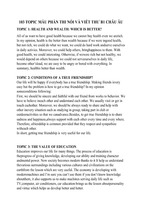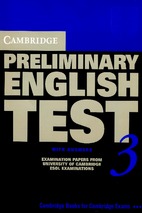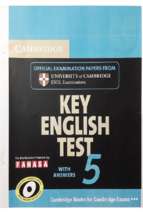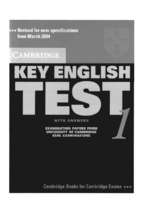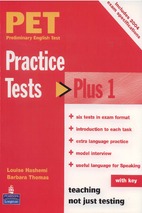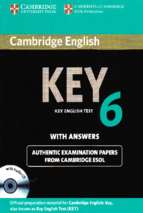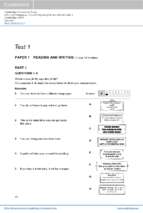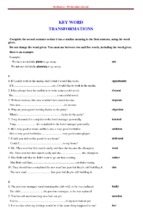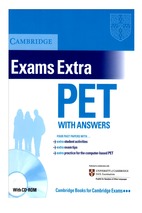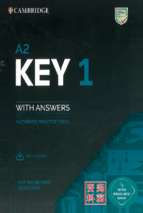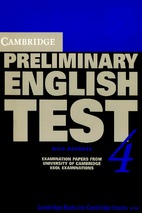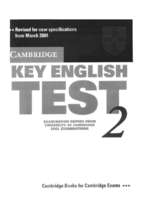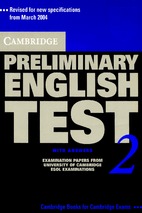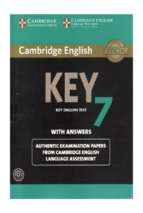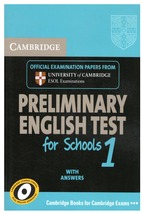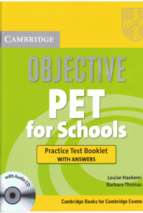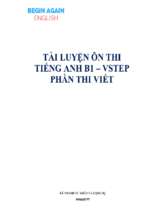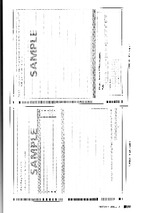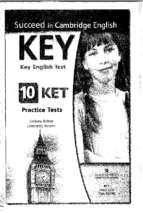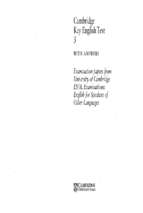VIETNAM NATIONAL UNIVERSITY – HO CHI MINH CITY
ENGLISH TESTING CENTER
Candidate name: _______________________ Candidate code: _______________
VNU-EPT
TEST BOOK
(No electronic devices or reference materials are allowed.)
Duration: 180 minutes
HCMC - 2013
VNU-EPT
Sample test
1
SECTION 1: LISTENING
The listening section, consisted of conversations and lectures, tests your English listening skills.
There are four passages and 32 questions, which are based on either stated or implied information
in the passages.
Each passage will be played twice. The questions will follow each passage. Each question has
four answer choices. Select the best answer for each question.
You may take notes while you listen and use your notes to answer the questions.
VNU-EPT
Sample test
2
PART 1 (20 pts)
Direction: In Part 1 you will hear ten conversations between two people. After the second listening
of each conversation, you will hear a question and there are four possible answers provided.
Select the best answer for each question.
1. (A)
(B)
(C)
(D)
At a romantic restaurant.
In a law company.
At Tom’s house.
At a movie theater.
6. (A)
(B)
(C)
(D)
$29.
Nearly $30.
$39.99.
$20.99.
2. (A)
(B)
(C)
(D)
In cash.
By debit card.
By credit card.
By check.
7. (A)
(B)
(C)
(D)
Interested.
Disappointed.
Annoyed.
Angry.
3. (A)
(B)
(C)
(D)
Buy some birthday cards.
Send some postcards.
Send some gifts to his six relatives.
Send some birthday cards to Peru.
4. (A)
(B)
(C)
(D)
Japan.
The U.S.
Kuwait.
Austria.
8. (A) The customer may be inexperienced.
(B) The customer sends e-mail too often.
(C) The customer has an important
business e-mail.
(D) He (the technician) knows what the
problem is.
5. (A)
(B)
(C)
(D)
They are worried, so they cannot eat.
They do not have enough time.
They are working.
They will leave work in ten minutes.
VNU-EPT
9. (A)
(B)
(C)
(D)
Australia.
Ireland.
Scotland.
America.
10. (A)
(B)
(C)
(D)
It was expensive.
It was cheaper.
It was his girlfriend’s choice.
It was more interesting than the trip
to Japan.
Sample test
3
PART 2 (20 pts)
Direction: In Part 2 you will hear a conversation or a discussion. After the second listening, there
are six incomplete sentences and four possible options provided for each gap. Select the best
option to complete the sentence.
11. The topic of the radio program probably is
“_____”.
(A)
(B)
(C)
(D)
14. Julie probably tells herself “_____” if she
learns to ride a bicycle.
Never think about past mistakes
How to be optimistic
Be positive in failures
Always use positive language
(A)
(B)
(C)
(D)
12. For Andy, _____ is very important.
(A)
(B)
(C)
(D)
15. Miriam says that we should _____ to
improve our bad feelings.
living for today
keeping past memories
arranging for the future
avoiding mistakes
(A)
(B)
(C)
(D)
13. Julie says people have negative thoughts
_____.
(A)
(B)
(C)
(D)
It will take me too much time.
I’ll fail again.
I’ll never try again if I fail now.
I can ride it soon.
do good things to other people
list all the things for a good future
keep a list of good memories at hand
try to have a good time every week
16. Michael doesn’t want to say “I’m sorry”
because he thinks _____.
if they fail in love
every time they fail
now and then
when they stop working
(A)
(B)
(C)
(D)
VNU-EPT
it’s not good to admit a mistake
action is more important than words
it’s better to say “I know my mistake”
positive language can encourage
people better
Sample test
4
PART 3 (28 pts)
Direction: In Part 3 you will hear a talk or a discussion. After the second listening, there are eight
questions. Select the best answer to each question.
17. What is the conversation mainly about?
21. What did his wife do for him before she
left?
(A) Why and how a man lost his memory.
(B) Things turn worse with a loss of
memory.
(C) Life of a man who lost his memory.
(D) A lost memory: a broken family.
(A) She did charity and prayed for him.
(B) She took care of him for a long time.
(C) She worked in a new center to take
care of him.
(D) She got good treatment for him in the
U.S.
18. Why did the man lose his memory?
(A)
(B)
(C)
(D)
He had an accident.
He has a virulent disease.
He’s getting old.
He has a genetic brain disease.
22. What happens when
children?
(A)
(B)
(C)
(D)
19. What is a result of his problem?
(A) Everything continually gets refreshed
to him.
(B) He lives a sad life in a hospital.
(C) He often gets lost and hurt.
(D) His wife left him and remarried in the
U.S.
20. If he says hello to a person at 8:00, when
will he probably say hello again?
(A)
(B)
(C)
(D)
Sometimes he calls their names.
They talk to him about their company.
He’s happy to see them.
He tells them they do not need to
come again.
23. What is
program?
(A)
(B)
(C)
(D)
8:07
8:05:07
8:30
8:00:07
he meets his
probably
his
favorite
TV
A football match.
A game show.
A comedy.
A movie.
24. What will the female speaker probably
do?
(A)
(B)
(C)
(D)
VNU-EPT
Visit the sick man.
Bring the sick man a piano.
Playing the piano for the sick man.
Wait to see the sick man on TV.
Sample test
5
VNU-EPT
Sample test
6
PART 4 (32 pts)
Direction: In Part 4 you will hear (part of) a lecture or a talk. After the second listening, there is a
summary of the lecture or the talk with eight gaps. Select the best option for each gap to complete
the summary.
The professor gives a/an (25) _____ of
globalization,
which
emphasizes
the
acceleration and intensification of economic
transactions among people, companies and
(26) _____. He then cites the U.S., the
International Monetary Fund and the World
Bank as the examples of (27) _____ and two
big international organizations that first involve
globalization. The professor also names Coca
Cola, McDonald, popular music and (28) _____
as representatives of U.S. cultural imperialism.
In the first point of the lecture, the professor
indicates that critics object to globalization
because poor countries are often badly
(29) _____ by international organizations to (i)
adjust currency, (ii) eliminate tariffs, (iii) respect
patents and copyright laws, (iv) privatize
(30) _____, and (v) not subsidize domestic
goods. To illustrate his point, the professor gives
an example of (31) _____, which suffered rather
than prospered. The professor then cites the
opinion of critics to globalization that these
organizations do not have good intentions to
help poor countries; they want to take
advantage of these countries instead.
However, the professor suggests two more
possible reasons for this practice. First, these
rules are also implemented to some extent in
rich countries. Second, poor countries which do
not follow trade rules will not receive (32) _____
from rich countries.
25. (A)
(B)
(C)
(D)
explanation
definition
clarification
argument
26. (A)
(B)
(C)
(D)
leaders of different continents
different nations in many regions
governments of various countries
similar governments of some nations
27. (A)
(B)
(C)
(D)
capitalism
imperialism
culturalism
popularism
28. (A)
(B)
(C)
(D)
TV celebrities
computer programs
advertising programs
television shows
29. (A)
(B)
(C)
(D)
supported
directed
advised
financed
30. (A)
(B)
(C)
(D)
large corporations
all public businesses
the business sector
industry and banks
31. (A)
(B)
(C)
(D)
South Korea
South Africa
Argentina
Indonesia
32. (A)
(B)
(C)
(D)
investments
nonrefundable aids
technology transfer
economic counseling
…
VNU-EPT
Sample test
7
SECTION 2: READING
The reading section tests your English reading skills. This section includes four reading passages
and 40 questions. Each question has four answer choices. Select the best answer choice. You
have 60 minutes to complete this section of the test.
The first passage tests your grammar and vocabulary.
The last 3 passages test your comprehension of the passages.
You may take notes and use your notes to answer the questions.
VNU-EPT
Sample test
8
PART ONE (40 pts)
Read the passage carefully.
TOURISTS IN A FRAGILE LAND
1 As a scientist working in Antarctica, I spend most of (33) _____ time in the lab studying ice.
I am trying to find out the age of Antarctic ice. All we know for certain is that it is the oldest
ice in the world. The more we understand it, the more we will understand the (34) _____
weather of the Earth. Today, as with an increasing number of days, I had to leave my work
to greet a group of tourists who were taking a vacation in this continent of ice. And even
though I can appreciate their desire to experience this vast and beautiful landscape, I feel
Antarctica should be closed to tourists.
2 Because Antarctica is the center of important scientific research, it must (35) _____
preserved for this purpose. Meteorologists are now looking at the effects of the ozone hole
that was discovered above Antarctica in 1984. They are also trying to understand global
warming. If the Earth’s temperature continues to increase, the health and safety of every
living thing on the planet will be affected. Astronomers have a unique view of space and are
able to see it very (36) _____ from Antarctica. Biologists have a chance to learn more about
the animals that inhabit the coastal areas of this frozen land. Botanists study the plant life
to understand how it can live in such a harsh environment, and geologists study the Earth
to learn more about how it was formed. There are even psychologists who study how
people behave when they live and work together in such a remote location.
3 When tourist groups come here, they take us away from our research. Our work is difficult, and
some of our projects can be damaged by such simple mistakes as opening the wrong door or
bumping into a small piece of equipment. Tourists in Antarctica can also hurt the environment.
Members of Greenpeace, one of the world’s leading environmental organizations, (37)
_____ that tourists leave trash on beaches and disturb the plants and animals. In a place
as frozen as Antarctica, it can take 100 years for a plant (38) _____ back, and tourists can
easily damage penguin eggs. Oil spills are another problem caused by tourism. Oil spills not
only kill penguins but can also destroy scientific projects.
VNU-EPT
Sample test
9
4 The need to protect Antarctica from tourists becomes even (39) _____ when we
consider the fact that there is no government here. Antarctica belongs to no country.
Who is making sure that the penguins, plants, and sea are safe? No one is responsible.
In fact, we scientists are only temporary visitors ourselves. It is true that the number of
tourists (40) _____ visit Antarctica each year is small compared to the number of those
who visit other places. However, these other places are inhabited by local residents
and controlled by local governments. They have an interest in protecting their natural
environments. Who is concerned about the environment of Antarctica? The scientists,
to be sure, but not necessarily the tour companies that make money from sending
people south.
5 If we don’t protect Antarctica from tourism, there (41) _____ be serious consequences for
us all. We might lose the results of scientific research projects. It’s possible that these
results could teach us (42) _____ about the causes and effects of climate change. Some
fragile plants and animals might die and disappear forever. This could damage the balance
of animal and plant life in Antarctica. We know from past experience that when things get
unbalanced, harmful changes can occur. Clearly, Antarctica should remain a place for
careful and controlled scientific research. We cannot allow tourism to bring possible danger
to the planet. The only way to protect this fragile and important part of the planet is to stop
tourists from traveling to Antarctica.
Task 1: Choose the best option A, B, C, or D for each gap.
33.
(A) our
(B) his
(C) her
(D) my
34.
(A) changed
(B) change
(C) changing
(D) changes
35.
(A) have
(B) be
(C) make
(D) do
36.
(A) clearly
(B) clarity
(C) clear
(D) unclearly
37.
(A) complaining
(B) complain
(C) complaint
(D) complained
38.
(A) to grow
(B) growing
(C) grow
(D) growth
39.
(A) great
(B) greater
(C) greatest
(D) most great
40.
(A) which
(B) whom
(C) who
(D) where
41.
(A) would
(B) need
(C) ought to
(D) may
42.
(A) important thing
(B) importance
(C) importantly
(D) something important
VNU-EPT
Sample test
10
Task 2: Choose the best option A, B, C, or D for each gap.
43. The word vast in paragraph 1 is closest in
meaning to _____.
(A)
(B)
(C)
(D)
48. The word remote in paragraph 2 is
closest in meaning to _____.
very large
pretty
small
faraway
(A)
(B)
(C)
(D)
44. The word landscape in paragraph 1 is
closest in meaning to _____.
(A)
(B)
(C)
(D)
49. The word disturb in paragraph 3 is
closest in meaning to _____.
an area of land for living
a painting
an icy environment
the way an area of land looks
(A)
(B)
(C)
(D)
45. The word preserved in paragraph 2 is
closest in meaning to _____.
(A)
(B)
(C)
(D)
closed
explored
protected
changed
(A)
(B)
(C)
(D)
rich and adventurous
careful
lasting for a limited time
responsible
51. The word consequences in paragraph 5
is closest in meaning to _____.
avoid
cover
prefer
live in
(A)
(B)
(C)
(D)
47. The word harsh in paragraph 2 is closest
in meaning to _____.
(A)
(B)
(C)
(D)
make somebody/something happy
bring somebody/something comfort
annoy somebody/something
cause somebody/something to die
50. The word temporary in paragraph 4 is
closest in meaning to _____.
46. The word inhabit in paragraph 2 is
closest in meaning to _____.
(A)
(B)
(C)
(D)
ideal
isolated
hostile
lonely
acquaintances
effects
causes
disasters
52. The word fragile in paragraph 5 is closest
in meaning to _____.
unpleasantly difficult
mild
dry
cold
(A)
(B)
(C)
(D)
VNU-EPT
native
rare
useful
easily damaged
Sample test
11
PART TWO (14 pts)
Read the passage carefully.
The white face, dark eyes and hair, and blood red lips: both foreigners and the Japanese are
fascinated by these beautiful and mysterious women.
Makiko is training to be a geisha. Not many girls want to be a geisha in Japan today.
Makiko’s parents want her to go to university, study medicine and become a doctor. But
Makiko’s grandfather paid for her training and bought the kimonos she needed. It’s very
expensive to become a geisha. You have to have a different kimono for each month of the
year, and today a kimono costs three million yen, that’s about $30.000.
It’s a hard life for a trainee geisha. She has to leave her family and move to a special
boarding house called a ‘maiko house’. Here, she has to learn traditional Japanese arts such
as playing instruments, performing the tea ceremony, arranging flowers, singing and
dancing. She has to take many difficult tests and exams. Only the best will pass everything
and become geishas many years later.
We asked Makiko to describe exactly what a geisha does.
‘A geisha has to serve customers and also entertain them. She has to sing and dance, and
make good conversations.’
Did she enjoy her life as a trainee geisha?
‘I love it. But it’s hard work. Sometimes I get tired of wearing the kimonos and I want to put on
a pair of jeans and go to school like a normal teenager. But I can’t have a normal life now. I
don’t mind. I feel very lucky.’
And what about later? Can she have a family?
‘Of course. A geisha can have relationships like anybody else and she can get married when
she chooses.’
In Japan today there are fewer than a thousand geishas, but they play an important role in
preserving Japanese culture and history.
VNU-EPT
Sample test
12
Choose the best option A, B, C, or D.
53. What is the main idea of the passage?
(A)
(B)
(C)
(D)
56. The word She in the passage refers to
_____
How to be a famous geisha.
Interesting life of geishas.
Life and work of geishas.
How geishas feel about their life.
(A)
(B)
(C)
(D)
Makkiko
A trainee geisha
The writer
A family member
54. Why is Makiko training to be a geisha?
57. Why does
ceremony?
(A) Her parents want her to do so.
(B) Her grandfather supported her
financially.
(C) She was lucky to be chosen.
(D) Being a geisha is Makiko’s dream.
the
writer
mention
tea
(A) To express he/she likes tea.
(B) To indicate that geishas love tea.
(C) To give an example of Japanese
traditional arts.
(D) To show that all Japanese drink tea
in a special way.
55. What is NOT a requirement for a geisha?
(A) She has to pass all difficult tests and
exams.
(B) She can’t stay home during the
training.
(C) She has to learn music.
(D) She has to play modern instruments.
58. The word them in the passage refers to
_____.
(A)
(B)
(C)
(D)
VNU-EPT
geishas
tests and exams
customers
conversations
Sample test
13
PART THREE (20 pts)
Read the passage carefully.
1 Climate encompasses the statistics of temperature, humidity, atmospheric pressure, wind, rainfall,
atmospheric particle count and other meteorological elements in a given region over a long period
of time. Climate can be contrasted to weather, which is the present condition of these same
elements and their variations over shorter time periods.
2 Climate may be inherently variable as evidenced by the irregularity of the seasons from one year
to another. This variability is normal and may remain partially understood. It is related to changes
in ocean currents, volcanic eruptions, solar radiation and other components of the climate system.
In addition, our climate has its extremes (such as floods, droughts, hail, tornadoes and
hurricanes), which can be devastating. However, in recent decades, a number of indicators and
studies show more and more evidence of climate warming across the globe. It is a disturbing
phenomenon challenging human habits and activities which are responsible for greenhouse gas
emissions.
3 The greenhouse effect is the process by which absorption and emission of infrared radiation by
gases in the atmosphere warm the planet's lower atmosphere and surface. It was proposed by
Joseph Fourier in 1824 and was first investigated quantitatively by Svante Arrhenius in 1896.
Naturally occurring greenhouse gases have a mean warming effect of about 33°C (59°F). But
human activity since the Industrial Revolution has increased the amount of greenhouse gases in
the atmosphere, leading to increased concentrations of CO2 and methane. The concentrations of
CO2 and methane have increased by 36% and 148% respectively since 1750. These levels are
much higher than at any time during the last 650,000 years. Over the last three decades of the
20th century, GDP (Gross Domestic Product) per capita and population growth were the main
drivers of increases in greenhouse gas emissions. CO2 emissions are continuing to rise due to the
burning of fossil fuels and land-use change.
4 There are two major effects of global warming: the increase of temperature on the earth by about
3° to 5°C (5.4° to 9°F) by the year 2100, and the rise of sea levels by at least 25 meters (82 feet)
by the year 2100. Other consequences are listed below:
- Amounts and patterns of precipitation are changing.
- The total annual power of hurricanes has already increased markedly since 1975 because their
average intensity and average duration have increased.
- Changes in temperature and precipitation patterns increase the frequency, duration, and
intensity of other extreme weather events, such as floods, droughts, heat waves, and
tornadoes.
- Lower agricultural yields, further glacial retreat, reduced summer stream flows and species
extinctions.
VNU-EPT
Sample test
14
Choose the best option A, B, C, or D.
59. What is the passage mainly about?
63. Why does the author mention fossil fuels
in paragraph 3?
(A) Differences between weather and
climate.
(B) Global warming and its effects.
(C) Climate warming across the globe.
(D) Consequences of global warming by
2100.
(A) To give an example of a source of
CO2 emissions.
(B) To indicate that fossil fuels burn well.
(C) To confirm that fossil fuels are the
only cause of CO2 emissions.
(D) To show the relation between fossil
fuels and land-use change.
60. According to paragraph 1, what
differentiates climate from weather?
(A)
(B)
(C)
(D)
64. What can be inferred from paragraph 3?
Elements.
Temperatures.
Time periods.
Locations.
(A) The greenhouse gases in nature
have a warming effect of about 33oC
on average.
(B) The concentrations of CO2 and
methane have increased by 36%
since 1750.
(C) The Industrial Revolution began in
1750.
(D) Population growth caused serious
gas emissions in the 19th century.
61. The word It in paragraph 2 refers to
_____.
(A)
(B)
(C)
(D)
number
evidence
globe
climate warming
65. According to paragraph 3, what is a
62. It can be inferred from paragraph 2 that
_____.
cause of the continued increase of CO2
emissions?
(A) climate changes from one year to
another
(B) scientists may not fully understand
climate variability
(C) climate extremes have just occurred
in recent decades
(D) humans produce more gases in
greenhouses
(A)
(B)
(C)
(D)
VNU-EPT
The production of fuels.
The use of man-made fuels.
The changed use of land.
The clearing of land for living.
Sample test
15
PART FOUR (26 pts)
Read the passage carefully.
COLUMBIAN EXCHANGE
1 The Columbian Exchange was the “exchange of plants, animals, foods, human populations
(including slaves) communicable diseases, and ideas between the Eastern and Western
hemispheres that occurred after 1492.” The term “Columbian Exchange,” coined in 1972 by
historian Alfred Crosby, took hold and became not only standard shorthand for the
phenomenon which it exemplified, but also a perspective for witnessing societal and
ecological events.
2 When Christopher Columbus made landfall with his crew in the Bahamas in October
1492, two worlds with separate evolutionary histories met. When Europeans began to
settle America’s east coast, they brought with them and cultivated familiar crops – wheat
and apples – as well as familiar weeds, such as dandelion and chickweed. In the 1600s,
they introduced cattle and horses, which flourished in the New World climate.
3 Devastating diseases were introduced to the American population which had no resistance
to them. John R. McNeill, professor of history at Georgetown University, points out that
“when the first inhabitants of the Americas arrived across the Bering land bridge between
20,000 and 12,000 years ago, they brought few diseases with them because they had no
domesticated animals, the original source of human diseases such as smallpox and
measles. In addition, as they passed from Siberia to North America, the first Americans had
spent many years in extreme cold, which eliminated many of the disease-causing agents
that might have traveled with them.” Consequently, between 1492 and 1650, over 90% of
the Native American population died in epidemic after epidemic of smallpox, measles,
mumps, whooping cough, influenza, chicken pox, and typhus. The loss of labor caused by
pathogens indirectly led to the establishment of African slavery among European
immigrants in the Americas, resulting in the importation of malaria and yellow fever from
Africa, causing even more destruction of the Native American population.
4 The export of American flora and fauna did not revolutionize the Old World as the influx of
European agriculture altered the New World ecosystem. According to Crosby, the New
World’s great contribution to the Old World was crop plants. Maize, white potatoes, sweet
potatoes, various squashes, chilies, and manioc augmented and invigorated the European
cuisine. Very few New World creatures traversed the ocean - the muskrat, the gray squirrel,
and a few others - but they did not precipitate large scale changes in Old World
ecosystems.
5 Although some diseases made the ocean voyage from New World to the Old World, they
did not have appreciable effects on the European population. Crosby stated that, although
some deaths were attributed to ailments from America, the total was insignificant compared
to Native American losses to smallpox alone.
6 In Crosby’s original work, he eschewed ideological statements. He reminded his readers
that neither the Old nor the New World was inferior or superior to the other, and the
encounter between the two worlds was fundamentally an exchange. By 1988, he
summarized his long view of the encounter in this way: “My point is that the impact of the
Encounter is so massive that we should consider it with the same sense of scale as we do
events connected with the endings and beginnings of the geological periods and eras and
their influence on the direction of evolution on the planet.”
Choose the best option A, B, C, or D.
66. What is the passage mainly about?
(A) Exchanged
things
between
Columbus and Native Americans.
(B) Social and ecological development of
the Americas after 1492.
(C) Inferiority of the New World to the
Old World.
(D) Exchanges between the Americas
and other continents since 1492.
67. Which sentence below best restates the
meaning of the highlighted sentence in
paragraph 2?
(A) When
Christopher
Columbus
reached the Bahamas in October
1492, he fell on the land.
(B) When Columbus’s group set foot on
the Americas, the Old World and the
New World encountered.
(C) Christopher Columbus claimed the
honor of discovering two separate
evolutionary histories.
(D) The Bahamas were the land where
Christopher Columbus met the
inhabitants of the New World.
68. Why does the author mention wheat and
apples in paragraph 2?
(A) To show the two familiar crops grown
in the Americas.
(B) To indicate that they are more
familiar than weeds and cattle.
(C) To give two examples of European
crops brought to America.
(D) To explain which crops Americans
chose to cultivate.
69. The word them in paragraph 3 refers to
_____.
(A)
(B)
(C)
(D)
inhabitants
Americans
the Americas
diseases
70. According to paragraph 3, between 1492
and 1650, Native Americans died of the
following European epidemics EXCEPT
_____.
(A)
(B)
(C)
(D)
mumps
influenza
malaria
chicken pox
71. It can be inferred from paragraph 4 that
_____.
(A) the Columbian Exchange had more
important impact on the Americas
than on Europe
(B) more Europeans liked the Old
World’s crops
(C) the New World animals did not
change the Old World ecosystems
(D) the muskrat and the gray squirrel
were the Old World creatures
72. Which of the following best demonstrates the Columbian Exchange?
(A)
(B)
(C)
(D)
malaria and yellow fever
crops, weeds, cattle and horses
disease-causing agents
smallpox and measles
SECTION 3: WRITING
The writing section tests your written English skills. There are two parts in this section.
Part One: You have 5 minutes to read a passage and 20 minutes to write a paragraph summarizing
the passage. You may take notes while you read and use your notes to write your summary.
Part Two: You have 35 minutes to plan and write an essay.
PART ONE: SUMMARY WRITING (40 pts)
Read the passage carefully and take notes.
CHILDREN AND TELEVISION
Television has been changing the way people live for thirty years. It influences nearly
every aspect of modern life. Whereas television could be used as an educational tool for
children, programs with little or no educational value are shown more often.
Experts are concerned about the view of the world that youngsters are learning from
television. Parents, schools, and churches have traditionally been the social models and
teachers for children. However, because television influences children’s attitudes and
behavior, its role in society is becoming increasingly more powerful – it is much more than a
simple recreational activity. The medium “has changed childhood more than any other social
innovation in the history of the world,” declares child psychologist Robert M. Liebert.
Exposure to excessive violence is another influence of television. According to several
studies, televised violence may cause children to become more aggressive. Also, because so
much violence is seen by children on television, they become more used to it as the only
solution to difficult situations. Children who watch a great deal of violence on television may
become apathetic toward actual aggression. One study has shown that, compared to a control
group, fifth-graders who watched an aggressive television broadcast were slower to ask for adult
help when a fight broke out among younger children. This decreased sensitivity to human
suffering is frightening, says psychologist Ronald S. Drabman.
- Xem thêm -

